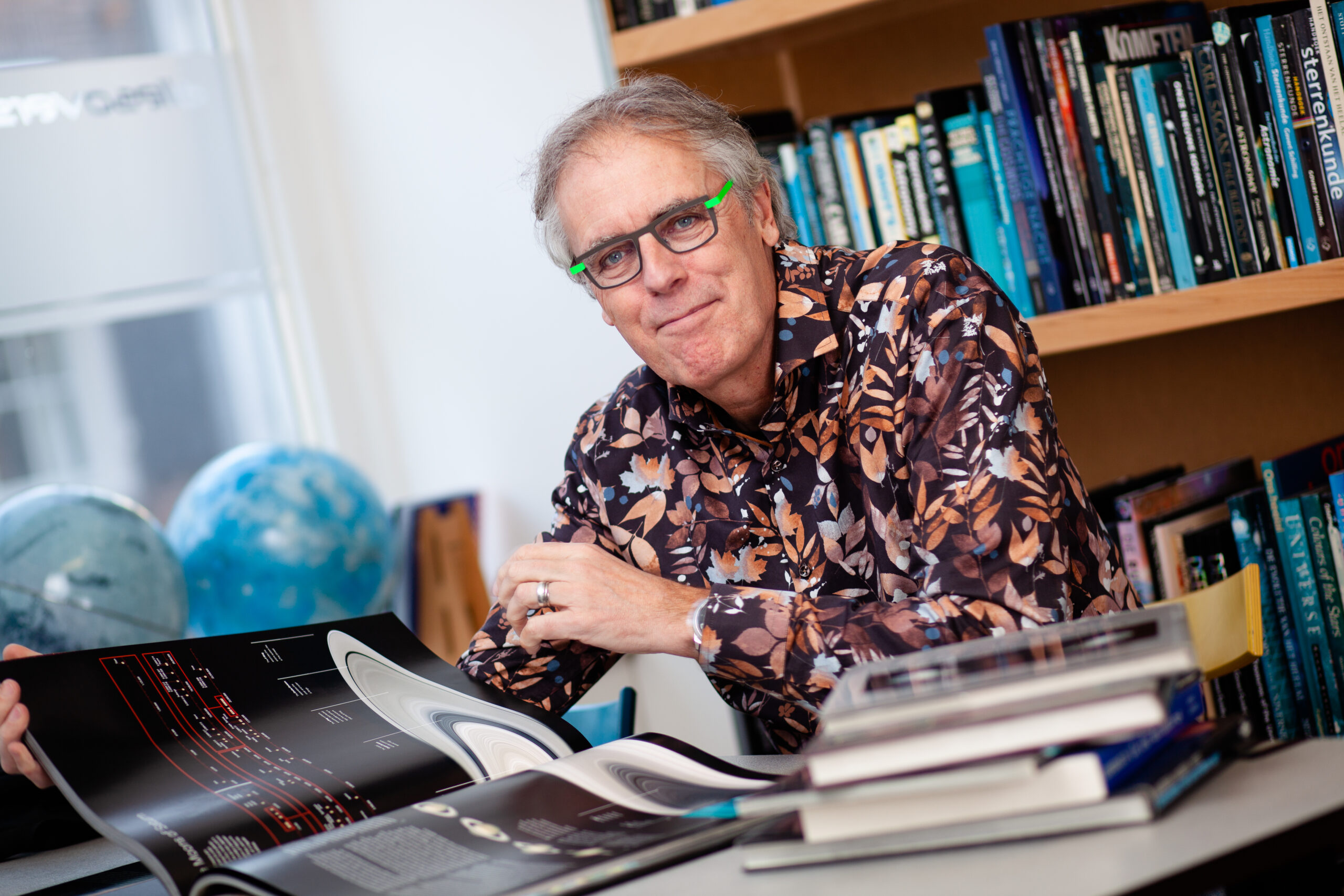
In his latest book’The Elephant in the Universe,Our Hundred-Year Search for Dark Matter‘, science journalist and publicist Govert Schilling tells us all about one of the greatest unsolved mysteries in modern astronomy. From the first indications of dark matter to the current state of affairs. Dutch innovations turn out to play an important role in this intriguing history. Not only that, generally speaking, astronomy has had more influence on technological innovations than we think. Innovation Origins puts a number of questions to Schilling.
Astronomy is the catalyst for numerous scientific developments and technological innovations. For example, the Dutch research organisation TNO tries to advance science through technological developments in astronomy. What is the importance of astronomy for science and innovation in your opinion?
“Astronomers and experimental physicists have always had a need for extremely sensitive and precise measurement equipment. This has led to important advancements on multiple occasions. Let me cite a few interesting examples. In our cell phones and digital cameras, we all have CCD chips (charge-coupled device, ed.) so we can take pictures. This technology was initially developed for military applications. Then it was picked up by astronomers and perfected and improved so much that we all now use it on an everyday basis. Therefore, outside of the covert military realm, astronomy was the first to experiment with light detector technology and has continued to develop it further.”
The second example is also a very cool one, because a lot of people don’t know about it. Our Wi-Fi protocol was invented by radio astronomers, so it originally came from radio astronomy. The radio astronomers wanted to figure out how to use small radio receivers to store and transmit encrypted information. This technology forms the basis of the Wi-Fi protocol as we know it today. Another special invention concerns the World Wide Web. This came from the CERN in Geneva.
The CCD chips, Wi-Fi and the worldwide web are three great examples of innovations that have made it big thanks to astronomy. Although they were originally developed for applications within astronomy, a much broader segment of the population now benefits from them.”
Your latest book revolves around dark matter. Despite the highly sophisticated set of instruments, astronomy is still – quite literally – in the dark in this area. Can you briefly explain what dark matter is all about?
“You could say that it is the mass that holds the entire universe together. This matter, along with its gravity, gives structure, evolution and coherence to the universe. Astronomers know for sure that this matter cannot be composed of the known particles, such as atoms and molecules. Nor is it made up of black holes or veils of dark, intergalactic gas. That’s what makes the mystery so enormous. We can measure that it is there. Everywhere, you can see the fingerprints of the gravity of dark matter.
But we still don’t know exactly what it is. No one expected that the riddle would remain unsolved up until this day. It remains a mystery. That’s what makes it so exciting. For example, there are now some skeptics and out-of-the-box thinkers who wonder whether dark matter exists at all or whether there is something missing from our concept of gravity. Which, of course, would be completely spectacular. Maybe there is no such thing as any substance whatsoever.”
Why did you want to write a book about this still elusive matter?
“The question of dark matter represents a major problem in astronomy. Very few people are aware of it yet. I did have some hope that there might be a revolutionary breakthrough around this time. After all, there are all sorts of developments taking place. There are new detectors and new research programs, for example. Of course, you never know such things in advance but it is a subject that is at a pivotal point for these sorts of developments.
There are a number of instruments that scientists are using to try to find dark matter. If that doesn’t work out in the next two years, we’re probably well and truly at a dead end. We can’t make those instruments even more sensitive. We might then have to either conclude that we’ll never find out, or that we’re looking in the wrong direction entirely. So yes, it’s a tricky topic in astronomy. But I would think it would be pretty amazing if it were soon discovered that it’s all completely different that what we think. Or that at least a solution is found.”
There was evidence of the existence of dark matter as early as the early twentieth century. Yet its existence has only recently been acknowledged.
“Dark matter is an age-old mystery that astronomers have been grappling with for a very long time. As I describe in my book, the Dutch astronomers Jacobus Cornelius Kapteyn and Jan Hendrik Oort, along with the Swiss-American astronomer Fritz Zwicky, played an important role in finding the first clues. They realized that the universe contains a lot of invisible stuff and tried to discover the nature of it all. Although their findings were fairly convincing, people couldn’t do much with them at the time. Besides, a lot of research was put on hold for a very long time due to the Second World War.
Another factor is that the subject was more or less ignored for a long time. People preferred to focus on issues where actual progress could be made. It was only over the course of the 1970s that the distant parts of the universe became more measurable. Then we could no longer ignore the existence of dark matter and far more people began to concern themselves with it.”
For the book, you have spoken to many scientists from different countries. Who are the major players in this field?
“If you look purely at the subfield of dark matter, it is mainly the United States, Europe and China. Inside Europe, the Netherlands still plays a key role. This is in part because radio astronomy began to develop here in the middle of the last century.
But also due to the fact that there is an enormous need in the Netherlands for international cooperation. Kapteyn was a trailblazer in this respect. As a result, a lot of countries now use our high-tech detection equipment, such as equipment for space telescopes and receivers for microwave radiation. As far as this is concerned, the Netherlands is in the top five in terms of these kinds of developments.
I secretly like the fact that all these important Dutch contributions are not overlooked in this book. I definitely haven’t exaggerated it but just call it like it is. The book was originally written for an American publisher and it is nice that Americans – and hopefully many other countries – are introduced to the considerable importance of Dutch astronomy this way. It really doesn’t all come from America.”
Do you think there might be a solution within reach after all, now that you’ve spoken to all these different scientists?
“If I’m being very honest, I’m not too optimistic. Look, there are some really big questions in science that no clear answer has been found for yet. For instance, we still don’t know exactly how the universe was created. And what about the existence of extraterrestrial life? That has been pondered and speculated about for a very long time. Dark matter is another example of such a big question. Perhaps these sorts of conundrums will remain unsolved for many decades to come.
But in the meantime, those big questions are what give direction to our research, as a kind of speck on the horizon. Consequently, we are discovering a lot of other things. For example, the search for extraterrestrial life has in recent years yielded a great deal of knowledge about the chemistry between stars, about the history of the planets in our own solar system, and about the existence of planets around other celestial bodies. The same holds true when it comes to the study of dark matter. This has been going on for forty years and it may well continue for a very long time. It would be a shame if we do not manage to solve it in the end but that is a very real possibility.”

336 pages
HARDCOVER
$29.95 • £23.95 • €27.00
ISBN 9780674248991
Publication Date: 05/17/2022








